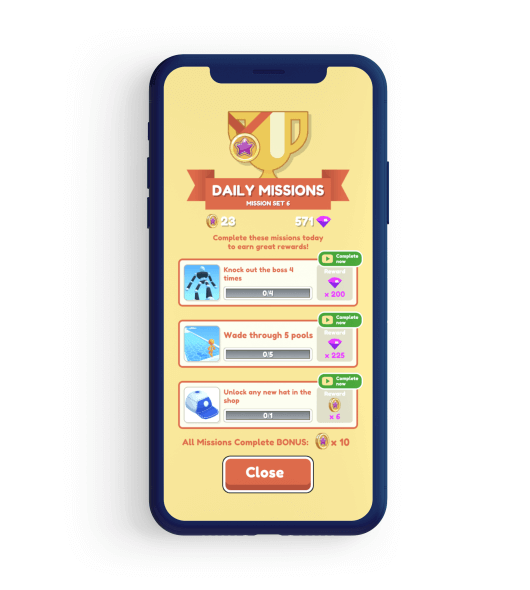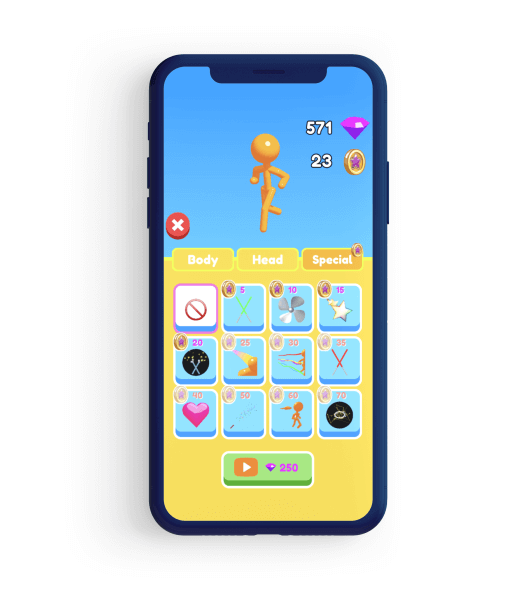This article originally appeared on gamedeveloper.com.
Tall Man Run was immediately a hit when Cartlon Forrester, the solo developer and Founder of VectorUp Games, published it with Supersonic in early 2022 - it reached #1 overall on Android and #1 in games on iOS in the US within three months after launch. Classic hyper-casual games were notable for their high marketability and quick rise in the charts - but they also tended to have lower LTV than other genres and fall in the rankings more quickly. Tall Man Run broke that stigma, and is still performing strongly today.
The game has maintained its place in the charts as a top 50 casual game for over a year, and has been a top 5 game in racing for a large portion of that time, all while increasing LTV and scale. So, what did Tall Man Run do differently to achieve this? That’s what we’re diving into.
Starting with a solid foundation
Tall Man Run showed it had potential to appeal to a wide audience and encourage stickiness (users continuing to return to the game) with three highly engaging elements:
- Runner mechanic
- Swiping gesture
- Gates
During initial testing, CPI was $0.40 and in-game metrics were high enough to move onto the iterations stage.
Addressing performance issues and tackling game design early on helped improve retention and set the game up for success later down the line. For example, when the game was initially developed on iOS devices, the level-end sequence featuring animated characters seemed to work well. When development moved to Android, though, these characters - which used skinned meshes - were glitchy. Replacing them with road barrier-like objects helped the level-end run smoothly and led to immediate performance improvements.
The Supersonic team and Carlton continued to tweak the game design to boost playtime and retention. They simultaneously launched UA campaigns - creative testing lowered CPI further (even reaching as low as $0.28) so Tall Man Run could scale profitably.
Then, they introduced ads during advanced testing once the game was already highly polished, which boosted ARPU. And by running additional A/B tests, they helped optimize performance, like testing the speed of gameplay which led to a D7 ARPU uplift of 6.6%.
Within three months of launch, Tall Man Run reached #1 overall on both Android and iOS in the US, achieving over 56 million installs and 250,000 daily active users.
Introducing new in-game elements to maximize ARPU and APPU
After its launch, Carlton alongside the Supersonic team continued optimizing Tall Man Run through monetization, in-game, and creative tweaks. By running effective A/B tests, they were able to improve the game’s LTV and ARPU - the following are the top tests that moved the needle most:
#1: End level meta layer
Testing a meta layer at the end of the level that lets users build a city encouraged greater user engagement and created additional opportunities for showing rewarded videos.
Users can progress through city maps, adding buildings to each map by accumulating currency from either moving through game levels or watching rewarded videos. And since some buildings can only be unlocked exclusively through rewarded videos, this further incentivizes users to engage with those ads.
Once implemented into the game, this meta layer led to a D7 ARPU uplift of 11% on iOS and 7% on Android.
#2: Daily missions
Introducing daily missions introduced a new way to enhance the sense of achievement users got by progressing through the game. Users can return to the game and see a new missions screen every day - by completing each of these, they earn a reward. And if they finish all of them, they receive a bonus.
During these missions - which act as additional goals for users to achieve during the game - users can engage with rewarded videos to earn boosters and upgrades that help them progress. They can also watch a rewarded video to automatically complete the mission and get one step closer to the all-missions-complete bonus.

Users can then use the currency earned from these missions to purchase items from an exclusive part of the in-game store.

Rolling out these daily missions, and the in-store page for users to spend their rewards, led to a boost in D7 ARPU of 3% on iOS and 5.5% on Android.
#3: Jetpack feature
Testing new features and obstacles in the game helped diversify the levels and encourage higher playtime and retention. One of these that made a big impact on KPIs was a jetpack.
Players can pick up the jetpack on the running platform then shoot into the sky for a little while to collect currency.
Giving users this engaging new feature and additional opportunity to earn currency led to a D7 ARPU increase of 2% on iOS and 4% on Android and an average rewarded video engagement rate of 14% on iOS and 12% on Android.
With each successful A/B test, Tall Man Run continued to improve profitability and in-game performance. Since launch, the game’s LTV has increased by 25% on iOS and 10% on Android. And, rewarded video engagement experienced a 100% uplift on Android and 70% on iOS.
In-game growth spurs creative success
As LTV increased, it was possible to start increasing bids on the UA side and attract higher-value users across more channels.
With this, a beneficial cycle of growth was established:
- In-game optimizations let the Supersonic UA team increase bids
- Higher bids bring in higher-LTV users that retain for longer and engage more with the game (and rewarded videos)
- High-value users that play for longer and engage with more rewarded videos boost in-game KPIs and ARPU
To continue increasing scale affordably, the UA team tested many new creatives. As a result, they found 38 booster creatives (ads that led to a significant uplift in KPIs and spend).
From these booster creatives, a pattern emerged of shared characteristics that clearly engaged users:
- Highlighting the decision-making aspect of the gates
- Focusing on the transformation of the character going through the gates
- Introducing humorous or surprising elements, like emojis
The close collaboration between the growth, UA teams, and developer boosted Tall Man Run’s performance even further. There were times when elements that performed well in the creatives were tested by the growth team and developer as features in the game - and vice versa, with the UA team trying successful elements from the game.
For example, the Supersonic UA team pulled out the top-performing environments in the creatives and shared them with the growth team, who then tested the backgrounds in the game. And the growth team shared the results of the tests featuring the jetpack, which clearly indicated it was a compelling element for users. Now, the UA team is testing creatives highlighting the jetpack.
Working across teams and constantly testing new creatives helped reinforce the game’s beneficial cycle of growth, increase scale, and attract high-value users that led to an increase in LTV. Through close collaboration, quick and high-quality implementation, and effective testing, Tall Man Run is able to sustain its incredible growth and popularity, even over a year after launch.
Let's put these tips to good use
Publish your game with Supersonic


